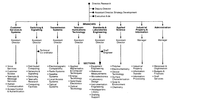


Chapter 8
I Part 1: Communications
i Before the Telegraph
ii Electrical Communication Before Federation
iii Federation to the End of the Second World War
iv Post-war and on to 1975
v 1975 ONWARDS
II Epilogue
III Part 2: Early Australian Computers And Computing
IV Acknowledgements
References
Index
Search
Help
Contact us

1975 ONWARDS (continued)
Turning again to research relating to telecommunications, from its humble beginning in 1923, the Telecom Research Laboratories developed into one of Australia's leading research organisations and one which is respected around the telecommunications world. Figure 35 depicts the present organisation and illustrates the extensive range of interests which are currently under investigation.In pursuing these activities 520 staff are currently employed, utilising equipment and facilities with a book value of $18 million and involving an annual operating cost of $36 million, including almost $2 million on extramural R&D shared between industry and academia. One objective of the latter is to assist various universities in sustaining excellence in particular fields related to telecommunications. Queensland, for instance, is a centre of excellence in microwave technology, New South Wales concentrates particularly on LSI techniques, Monash on Material Science, Adelaide on Signal Theory and Traffic Engineering, and Western Australia on local area networks.
Among the Laboratories' own activities, key studies are currently concentrated on fields which include:
- New optical fibres, based on zirconium tetra fluoride, in the infra red range for longer regeneration spans (10 times longer) and wide bandwidth
- Opto electronic devices (frequency controlled lasers, using mercury cadmium tel-luride), to enable wavelength multiplexing on fibres, giving greatly increased capacity
- Optical fibre and cellular radio for local reticulation
- Electronic directory services
- Interworking of teletex, telephony, packet switched data and ISDN networks
- Protocol engineering for new services
- Fast packet switching for the broadband ISDN

One area in which Telecom's Research Laboratories have gained an international reputation for expertise is in the protocol engineering -the specification, validation and testing of new protocols and signalling systems for the ISDN-era networks. Since 1973 they have made major contributions to the development and international standardisation of the CCITT's Specification and Description Language (SDL), now used by the CCITT and most telecommunications authorities to specify new signalling systems.[70] Since 1976 they have developed a methodology and a computer aid (PROTEAN) for specifying and exhaustively validating protocols, which Telecom has since been successfully exporting, via its new subsidiary Telecom Australia International Limited. In 1986 they began joint development with Siemens (Australia) Ltd. of an ISDN protocol tester, that will have a crucial role in verifying the compatibility of ISDN terminal equipment with ISDN exchanges and PABXs.
To co-ordinate and give overall focus and direction to research, development and innovation work, within practicable resources, Telecom operates a rolling forward-looking three-year corporate programme, which is reviewed annually. The RDI programme covers any research, development and innovation work which contributes to a result that has a national application and includes:
- The research for, and evaluation of, potential applications of new scientific and engineering knowledge and technology directed at extending the range and quality of customer facilities and services or of providing the existing range more efficiently and effectively
- technical development, including adaptive design of new types of equipment or systems which are selected for application in the network and modification design of existing equipment to overcome defects and deficiences
- technical implementation design aimed at introducing new or improved customer services, systems, procedures or practices into the operations of Telecom Australia, using either existing or new technology
The nature of the capital investment programme for international communications, with rather large projects at infrequent intervals and incorporating much specialised technology, developed for the larger overseas market, has limited the extent to which Australian industry has, in the past, been able to participate in these projects. Although OTC has, from time to time, let contracts for research into problems particular to its needs, it has not had an ongoing research programme.
Organisations in Australian Science at Work - CCITT (International Consultative Committee for Telephony and Telegraphy); Siemens (Australia) Ltd; Telecom Australia (Australian Telecommunications Commission); Telecom Australia International Limited
 |
Australian Academy of Technological Sciences and Engineering |  |
© 1988 Print Edition pages 608 - 609, Online Edition 2000
Published by Australian Science and Technology Heritage Centre, using the Web Academic Resource Publisher
http://www.austehc.unimelb.edu.au/tia/581.html